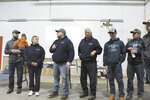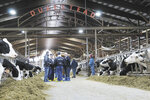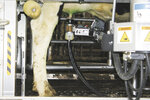


ABBOTSFORD, Wis. — An aging parlor, a lack of reliable labor and a desire for flexibility in their workday led the Dukelow family to embrace the transition to a robotic milking system on their Clark County dairy farm.
Dukestead Acres Inc. is operated by brothers Chris, Greg and Jon Dukelow and their parents, Jim and Marilyn, along with Chris’s wife, Monica, and sons, Aaron and Nathan, and Jon’s wife, Marisa, and son, Hudson.
The farm is home to 450 cows that are milked with seven DeLaval VMS V300 units.
The family shared their experience of retrofitting their facility April 9 during a University of Wisconsin Extension open house in Abbotsford.
“We’re a true family operation,” Greg said. “Everyone pitches in. That is what makes us successful.”
The Dukelows had known for several years that updates were needed on their farm.
“Our parlor was over 20 years old,” Monica said. “We were faced with the decision of replacing the parlor or taking advantage of the advancements in technology, moving forward with robots. The labor struggles we were facing helped make that decision.”
Jon said that robots had been on his radar for a few years.
“We had some high school workers who graduated the year before we put the robots in,” Jon said. “They were hard to replace. The lack of dependable labor was really a driving factor.”
With the idea of robots in their sights, Jon said they have been breeding their cows with a focus on creating robot-ready cows for several years.
“We’ve always mapped our cows to have good udders,” Jon said. “In the past 5-6 years, we have been focusing on square udders with no reverse tilt and (ideal) teat length. We always have enough heifers on hand, so if some don’t work out for the robots, we can always sell them on a dairy sale.”
Between 55%-60% of the herd is bred using beef semen. The Dukelows use sexed semen on the balance to ensure an ample replacement heifer population.
The robotic milking era at Dukestead Acres was launched in January 2023 with six robots.
“We really liked the guided-flow setup to help decrease the amount of pellets we’d need to feed,” Jon said. “We have had a great working relationship with Bob’s Dairy. Those were the reasons we chose the DeLaval robots.”
The Dukelows’ barn was lengthened by 60 feet. The barn has two pens that are each equipped with three robots positioned side by side and a smaller pen housing the seventh robot. This is an unusual configuration, according to Richard Franta, a solution sales specialist with DeLaval.
“Dukestead Acres is herd No. 1 that put three robots in a row — what is called a stacked tollbooth,” Franta said. “It’s been great to see how well it’s worked, opening up a lot of possibilities for cow flow in the future. We now have a herd putting six robots in a row this way because of how well they saw it work here. It’s a neat thing to be on the cutting edge of new design technology.”
The seventh robot was installed in March 2023. Having only one robot in that pen, the Dukelows can maintain a small group of heifers in training or older cows.
“We can pay closer attention to some of those cows,” Greg said.
The Dukelows did not stop at robotic milking when upgrading the technology in their barn. They utilize a Valmetal robotic feed pusher and two Valmetal bedding robots that operate on a track system, delivering bedding to the free stalls. With the use of the bedding robot, they only disturb the cows to groom stalls every other day using a small utility tractor.
“We put in a manure separator in 2017 and have been bedding with manure solids since then,” Jon said. “We’ve been really happy with that.”
The Dukelows were one of the earliest installers of the DeLaval Plus Behavior Analysis system. The setup tracks rumination and activity for heat detection and also allows individual cows to be located within the barn through a series of additional antennas placed throughout the barn.
“The system allows you to be able to locate any cow in the barn at all times, within a couple of inches,” Franta said. “It’s a really neat feature to be able to look for cows, sort them and see how the cows are working within your barn.”
Jon agreed that the system saves time when seeking individual cows.
“Sometimes, you’d be looking for one particular cow and you just can’t find her,” Jon said. “This eliminates a lot of time spent walking in the pens and disturbing the cows. I like that it is an ear tag instead of a collar too.”
The Dukelows have seen improvement and growth in their herd’s performance.
“We increased production the second day in the robots, and we’ve just been crawling up since then,” Greg said. “We attribute that to the increase from milking twice a day in the parlor to the average 2.5-2.6 milkings per day the cows are achieving in the robots. We’re doing about 170-180 milkings per day per robot. It’s a little over 6,100 pounds of milk per robot.”
They typically look for fetch cows in the morning and the afternoon, ensuring all cows are visiting the robots on time.
“It was a fun first week in the robots, but every week since then has gotten better,” Chris said.
The Dukelows feed their cows a total mixed ration once a day, and the cows consume an average of 7 pounds of pellets in the robot.
The increased flexibility in their daily schedules has allowed the family to spend more time focusing on their cropping enterprises as well as the custom work they do.
“We work about 1,700 acres and do all our own cropping, manure spreading and spraying,” Greg said.
All in all, the Dukelows agreed that the robots have improved their enterprise.
“We’ve been really happy with how the cows have adapted,” Jon said. “We were pleased with how easily the whole retrofit has worked in the existing barn.”
The Dukelows’ barn will be open to the public June 2 when they host the Abbotsford Dairy Breakfast.
Comments
No comments on this item Please log in to comment by clicking here